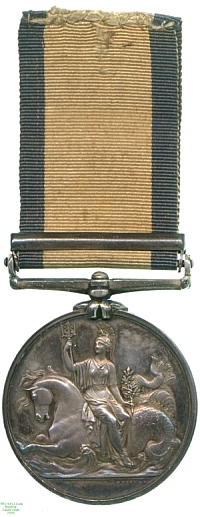
Obverse, a bust of Queen Victoria

Reverse, Britannia with a trident seated sideways on a seahorse

Obverse, a bust of Queen Victoria |

Reverse, Britannia with a trident seated sideways on a seahorse |
Just as in 1848 the extensive land campaigns of the Napoleonic Wars and the other conflicts of the pre-Victorian era were recognised by the issue of the Military General Service Medal, those serving in the Navy at the time were recognised with the Naval General Service Medal. As with the Army equivalent and the East India Company's related award, many of the battles for which the medal was awarded had been fought so long ago that few if any claimants survived.
In addition, bars were awarded for many actions whose significance and size were, despite the heroism displayed by those involved, relatively minor. The result was that many of the bars were issued in tiny numbers, with some combinations all but unique, and the medals command a very high price among collectors because of this rarity and individuality. This in turn, along with the manufacture in most cases of more bars than were eventually issued, has led to the `improvement' of many common awards where recipients' names are shared with those present at `rarer' battles. The medal also shares with the Military General Service and Army of India Medals the oddity that Queen Victoria, whose portrait they bear, was not the ruler under whom the battles for which it was awarded were fought.
The bar on this medal relates to an engagement by British ships against three French commerce raiders, the frigates Arienne and Andromache and the brig Mameluke, which after a successful cruise against British merchantmen were caught of the Isle de Groix by the frigate HMS Northumberland and the sloop HMS Growler, and all three grounded and destroyed in explosions in the subsequent battle.
This medal is inscribed to Boy John Carter, a trumpeter aboard the Northumberland at the time of the battle. His presence on the ship at this time has been verified, and the Medals Roll confirms the award of this medal to a man of this name, but it must be noted that two men of this name also qualified for the much more common issue with the bar for Syria. As there were only 62 bars issued for Northumberland, it would be a temptation for a forger to have retooled either of the Carter Syria medals as one of this issue. Nonetheless, as such a medal as this certainly has existed, there is no a priori reason to doubt that this piece is it. This was one of the last pieces acquired for the Watson Collection: Lester Watson purchased it from the London dealers Baldwin in 1936. They had come by it from an auction at Glendinings in September 1935.